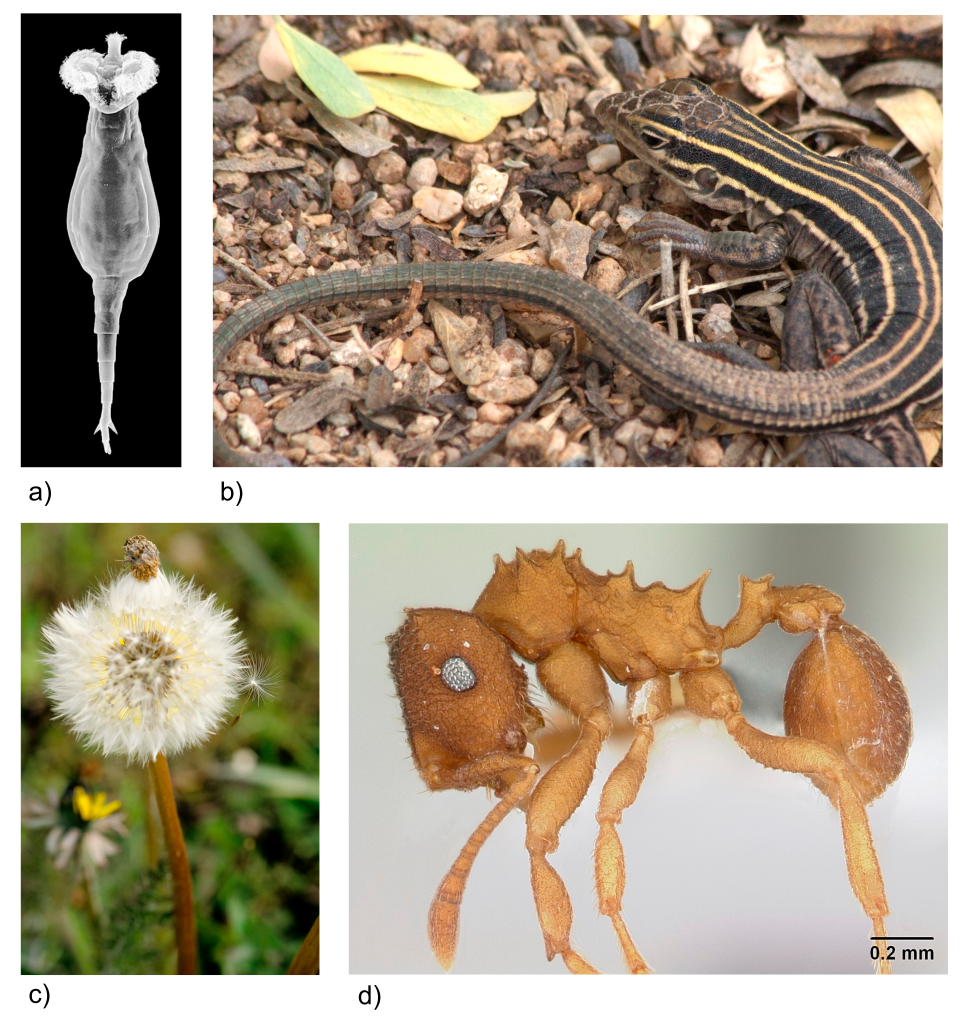7.2 Sex is a Problem
Is sexual reproduction the norm?
As humans, we tend to be pretty focused on ourselves. Humans reproduce by having sex, so we might assume that all other organisms engage in sexual reproduction as well.
It’s true that all mammals reproduce sexually. But looking at all species across the planet, many organisms are actually asexual — they produce genetically identical clones, without mating with another individual.
Asexual reproduction is the norm among bacteria like E. coli, algae like Volvox, and microscopic animals called bdelloid rotifers. Many organisms are capable of both forms of reproduction. For example, the yeast that we use to make beer and bread can reproduce asexually or sexually. Female zebra sharks will reproduce asexually if they are unable to find a male to mate with. Many plants, such as dandelions, produce “plantlet” clones, but can also reproduce sexually by producing flowers, which are pollinated and form seeds.

The benefits of asexual reproduction
Asexual reproduction seems to work just fine for many species, or else all of the species mentioned above wouldn’t exist. Asexually reproducing organisms don’t need to find a mate — they can reproduce on their own without any need to attract a mate or waste time with copulation. Many asexual organisms don’t need to undergo meiosis, which can be slow and costly. They also don’t run the risk of catching sexually-transmitted diseases.
Another major benefit of asexual reproduction is that it avoids what is called the “Two-Fold Cost of Sex.” Let’s explore what this means.
The Two-Fold Cost of Sex
The cost of producing males:
Imagine an organism that reproduces asexually, like the asexual whiptail lizards introduced in Section 7.0. All whiptail lizards are female! When a whiptail lizard reproduces, she clones herself, producing one or more daughters. All daughters are capable of reproducing themselves, so each offspring a female makes is capable of reproducing. Our original female will likely have many daughters, granddaughters, great-granddaughters, and so on.
Now imagine an organism that reproduces sexually. Populations of sexually-reproducing organisms (typically) consist of both males and females. Only females are directly capable of producing offspring — males produce sperm, but it is the females who directly create the offspring. When a female reproduces, she produces both males and females. Essentially, she wastes time and resources producing and caring for male offspring in addition to female offspring. If the females were asexual, they would produce only females and those females could produce females, and so on. But in a sexual species, females must produce twice as many offspring to produce the same number of female offspring.
The cost of passing on fewer genes:
Asexual females produce clones. That means that they pass 100% of their genes on to their offspring. In contrast, sexually-reproducing females only pass on 50% of their genes to their offspring. Think back to what we learned about evolution and natural selection in Chapter 2. Organisms with high fitness are those that pass on as many of their genes as possible to the next generation. Combined with the cost of producing males, the cost of passing on fewer genes further increases the overall cost of sexual reproduction.
So, why have sex?
When you sum up the wasteful production of males and the lower genetic contribution to the next generation, sex is expensive! So, why does it exist? Despite the benefits of asexual reproduction and costs of sexual reproduction, sexual reproduction is the major mode of reproduction among multicellular organisms. This begs a hugely important question in evolutionary biology: Why are so many organisms sexual?
The short answer to this question is, “nobody really knows.” But scientists have many guesses. Of the many hypotheses, two particularly strong hypotheses are: 1) sex speeds up evolution; and 2) sex helps repair mutations and can purge organisms’ lineages of harmful mutations.
We’ll discuss the first hypothesis now, and explore the second hypothesis in the next section.
Does sex speed up evolution?
Biologists have suggested that a major benefit of sexual reproduction is to speed up evolution. When an organism reproduces sexually, her offspring have a new combination of genes — 50% from herself and 50% from her mate. In addition, the genes she passes on to different offspring are all shuffled up because of crossing-over during meiosis. This means that all of her offspring are different from one another, genetically. To summarize, asexual organisms produce clones. Sexual organisms produce offspring with many different gene combinations.
How would producing offspring with many different gene combinations speed up evolution?
Evolution by natural selection requires variation. (Recall the 3 requirements of natural selection from Section 2.10.) If there is more variation, evolution can happen more quickly.
Why does faster evolution increase an organism’s fitness? Her lineage (her children, her grandchildren, great-grandchildren, etc.) can evolve more quickly, and therefore adapt to selection pressures like changing environments, greater competition, and threats of predators and pathogens. (Remember, evolution happens to populations, not individuals. Because her lineage has greater genetic diversity, some of those individuals are bound to have the right combinations of genes to survive these selection pressures.)
This does not mean that all sexually-reproducing species are constantly changing. Plenty of successful sexual organisms have changed little across long spans of time. For example, the coelacanth fish that exists today seems nearly identical to fossilized coelacanths that existed millions of years ago (Figure 7.3 and 7.4).


Check Yourself

